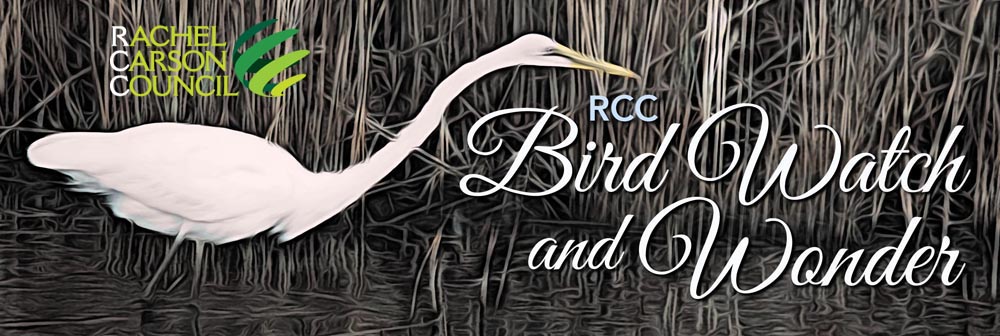 | | | Welcome to the April edition of the Rachel Carson Council’s Bird Watch and Wonder. In the midst of spring migration, we are ready to share some of the most important, interesting, and sometimes distressing bird and birding stories from the last month. But, as the illegal and horrifying Russian invasion of Ukraine grinds on with its huge human toll, we also look, in a special section, at the effects of war on the environment, including a powerful original essay by Bob Musil. In the "Books" section, you’ll also find Musil’s review essay on the latest writer to lay claim to the legacy of Rachel Carson – David George Haskell and his Sounds Wild and Broken. And in the "Bird Lore" section, you’ll also find Ross Feldner with his latest, a fresh take on the astounding variety and diversity of birds, Flight of Fancy. 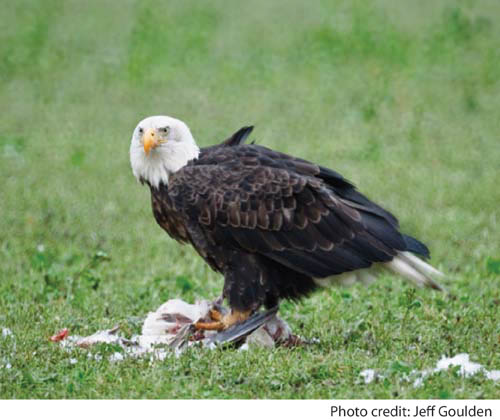 Unfortunately, birds are also suffering here at home because the avian flu has caused the death of millions of birds in the United States. There have been outbreaks of avian flu in the recent past; however, experts believe this one may be here to stay. Unlike past strains, this strain infects wild birds that can then stay healthy with the disease in their body for long periods of time. This means that they can transmit it to many other birds, wild or not. In fact, some scientists are recommending that birders take down their bird baths and bird feeders to reduce the spread of this flu. Unfortunately, birds are also suffering here at home because the avian flu has caused the death of millions of birds in the United States. There have been outbreaks of avian flu in the recent past; however, experts believe this one may be here to stay. Unlike past strains, this strain infects wild birds that can then stay healthy with the disease in their body for long periods of time. This means that they can transmit it to many other birds, wild or not. In fact, some scientists are recommending that birders take down their bird baths and bird feeders to reduce the spread of this flu. 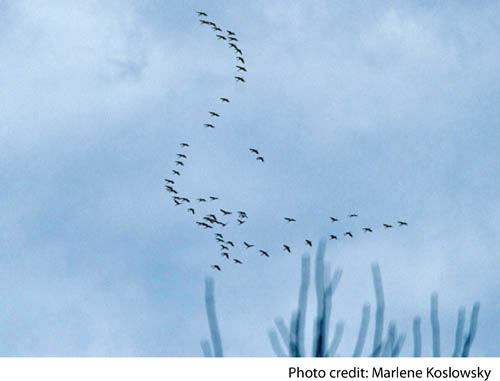 Fortunately, not all the bird news this month has been bad. Research on bird migration, flock murmurations, and the impacts of climate change published in April has helped make strides in conservation efforts and our understanding of the world around us. Fortunately, not all the bird news this month has been bad. Research on bird migration, flock murmurations, and the impacts of climate change published in April has helped make strides in conservation efforts and our understanding of the world around us.
For more bird news, books, events, and our special section on the environment and war, continue reading our April issue of Bird Watch and Wonder. | | | | | | | | | | 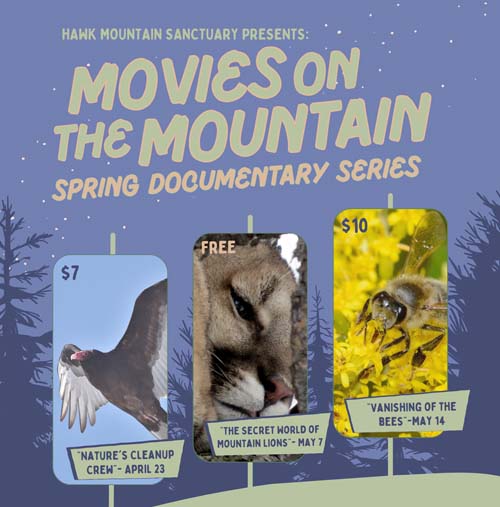 Hawk Mountain to Host Spring Documentary Series Hawk Mountain to Host Spring Documentary Series
Hawk Mountain Sanctuary is hosting Movies on the Mountain, a Spring Documentary Series, three Saturdays in April and May 2022. Join us in our beautiful outdoor Amphitheater to view these exciting and educational documentary films!
“Giving the public the opportunity to get an inside look into the natural world through photo and video footage that they wouldn't normally get to see can encourage people to connect with and appreciate nature,” says Riley Davenport, Education Specialist. “There are several barriers that keep people from connecting with nature, and photography and film are a way to get people a bit closer.” Read more | | | | | | 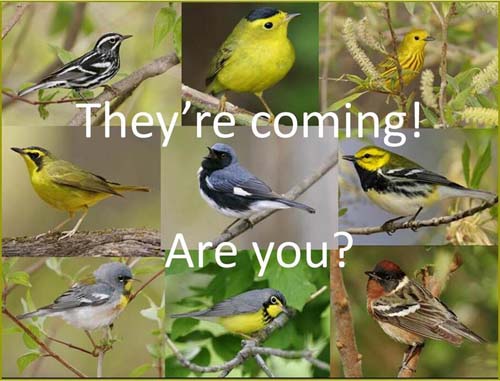 The Biggest Week in American Birding The Biggest Week in American Birding
Black Swamp Bird Observatory (BSBO) is thrilled to announce that they are planning an IN-PERSON festival for 2022! They’re adding some exciting new field trips, and all of your favorite Biggest Week activities are back, including the Birder's Marketplace, Bird Tattoo Contest, Birder Prom, Bird Trivia Night, and MUCH more! May 6th to the 15th, 2022.
The field trip dates and locations are up and available on The Biggest Week website >>>CLICK HERE TO VIEW! | | | | | | A ‘Silent Victim’: How Nature Becomes a Casualty of War Research on past conflicts suggests that the war in Ukraine could have a profound environmental impact. The Black Sea Biosphere Reserve, on the southern coast of Ukraine, is a haven for migrating birds. More than 120,000 birds spend the winter flitting about its shores, and a multicolored spectrum of rare species — the white-tailed eagle, red-breasted merganser and black-winged stilt, to name just a few — nest among its protected waters and wetlands. | | | | | | War in Ukraine Poses Environmental Risk Now and in the Future, Advocates Say As Russian forces bombard communities across Ukraine, the nation’s once-vibrant ecosystems are becoming scorched and scarred, rewinding decades of conservation work, according to Ukrainian climate advocates. Svitlana Romanko, a Ukrainian climate justice activist and former environmental law professor, told The Climate 202 that the consequences of the damage on the environment and biodiversity after the war will be felt for years to come. | | | | | | Should Environmentalists Worry About War? In his strong State of the Union speech, rapidly redrafted to focus on the Russian invasion of Ukraine, President Joe Biden barely mentioned the environment and global climate change. Though an understandable shift in this time of war, when large numbers of human lives and the freedom of Ukraine are at stake, it is an unfortunate one. War, preparations for it, and the production and maintenance of large arsenals, especially nuclear ones, are among the largest threats to the environment and of global climate change on the planet. | | | | | | | | How and Why Did Bird Migration Evolve? The drive for birds to migrate is at least partially genetic. How those genes developed—and how they function in modern birds—isn't fully known. As spring unfolds in North America, the days lengthen and warm, flowers push out of thawing soils, and green leaves bud on branches. Bees get busy, and birds court mates, build nests, and raise young. As any winter-hardened birder knows, many of those birds have been absent, passing harsh, cold northern months in warmer southern climates. Some have flown thousands of miles to arrive to their breeding grounds in the same place, at about the same time. | | | | | | A Brief History of How Scientists Have Learned About Bird Migration Researchers today can follow birds' paths as they fly thousands of miles. But it wasn't always that way. Scroll through more than two centuries of advances in understanding this natural wonder. Bird migration is one of the most fascinating and inspiring natural phenomena—but how do scientists figure out where all those birds are going? From the earliest origins of bird banding to high-tech approaches involving genomic analysis and miniaturized transmitters, the history of bird migration research is almost as captivating as the journeys of the birds themselves. | | | | | | | | Bird Flu Epidemic Has Claimed at Least 36 Bald Eagles Outbreaks of H5N1 have forced farmers to kill at least 27 million chickens and turkeys. Raptors and birds of prey are also succumbing to the virus. A virulent bird flu epidemic that's resulted in nearly 27 million chickens and turkeys being destroyed in 30 states has also killed dozens of bald eagles. First detected in the US in January, H5N1, a strain of highly pathogenic avian influenza, has been reported across the Midwest, South and East Coast. At least 36 bald eagles have died as a result of contracting the virus since then, according to the U.S. Department of Agriculture. | | | | | | | | Commentary: It’s Easier Than You Might Think to Make Birding More Accessible to More People Birds bring so much joy to so many people. Their presence and our delight in them can connect us to the natural world. And with so many health benefits to spending time outside, birds can be the prompt to get a dose of nature therapy. Some have turned this connection into a verb: “to bird.” As a bird lover and an occupational therapist, I think it’s time we expanded how we think about birding, and who can be a birder. | | | | | | Philly Bird-watching Groups Are Changing the Way We See Birds Early on a recent Sunday morning, about a dozen people gathered at FDR Park in South Philadelphia to go bird-watching. Most of them were new to birding. Many did not have their own binoculars. They got a lot of help from their guide, Jason Hall, who distributed loaner binoculars to anyone who needed them. He immediately set up his spotting scope in the parking lot so everyone could get a close look at the large black-backed seagull perched on the roof of the Boathouse. | | | | | | | | It’s Birdwatching Season, and Climate Change is Sending Birds Much Earlier The pandemic made birdwatching more popular, but the timelines are shifting on when some of the most cherished birds arrive. On a crisp recent afternoon at Montrose Point Bird Sanctuary, Marian Runk, a 41-year-old illustrator, folk singer and Avondale resident, searched for whatever was out, her binoculars in hand. Runk, whose father passed on the hobby, has been birdwatching for 15 years. She hoped to see an early yellow warbler. But like many birders, she was happy to see anything that flutters. | | | | | | | | | | A Flock of Beautiful Birds in a City Is a Miracle, a Disaster and a Conundrum In the summer of 2020, a massive flock of purple martins set up camp in the trees surrounding the Schermerhorn Symphony Center, in the heart of downtown Nashville. The birds had left their nesting territories, both nearby and farther north, and were gathering in preparation for the fall migration. They stayed for two months. The flock was a glorious sight — 150,000 birds descending from the sky night after night — but the problems they created for the cash-strapped symphony were extensive. | | | | | | | | Why Do Flocks of Birds Swoop and Swirl Together in the Sky? A Biologist Explains the Science of Murmurations A shape-shifting flock of thousands of starlings, called a murmuration, is amazing to see. As many as 750,000 birds join together in flight. The birds spread out and come together. The flock splits apart and fuses together again. Murmurations constantly change direction, flying up a few hundred meters, then zooming down to almost crash to the ground. They look like swirling blobs, making teardrops, figure eights, columns and other shapes. | | | | | | Birds of the U: Capturing a Natural Aviary in Our Own Backyard At the brightest hours of the day, some students may spot something quite incredible at the heart of campus. Looking across Lake Osceola from the entrance to Eaton Residential College, next to the School of Architecture, a lucky few will find a magnificent osprey perched atop the roof’s edge of the Donna Shalala Student Center. Such a graceful yet powerful apex predator will occasionally swoop its way across the lake to a nearby tree, protecting its nest and warning others with a series of intense chirps. | | | | | | Many Birds Are Laying Their Eggs Earlier Than 100 Years Ago, By Almost a Full Month Changes in climate are to blame. Many species of birds seem to be nesting and laying eggs much earlier than they did a hundred years ago — almost one full month earlier. The culprit seems to be climate change. Spring is upon us, and soon, so will newly-hatched birds. But new research from the Field Museum of Natural History in Chicago, Illinois, says that at least some of these baby birds will arrive much earlier than they would have one hundred years ago. | | | | | | Biologists Have Cracked the ‘long-standing mystery’ of Egg Mimicking in Birds Or, how to trick someone else into raising your kids (according to birds). Easter eggs are wonderfully colorful and sometimes full of chocolate. While it remains an absolute mystery of nature how and why a rabbit lays and delivers these piebald, tasty eggs to children on Easter Sunday, another egg-citing mystery of the natural world has been poached — um, broached. | | | | | | | | Flight of Fancy “An idea, story, etc., that shows great imagination but is very unlikely to be true or practical.” There are so many astounding facts about birds it would be impossible to list them all. There are birds that have claws on the ends of their wings until they are old enough to fly. This means when they are young and vulnerable they can elude a predator by climbing up a tree. This also speaks to the idea that birds are descendants of dinosaurs. There are birds that have a bill nearly as long as their body and birds that dye their feathers. Considering the diversity of birds, from their size, to their habits and color, it’s no wonder they seem magical at times. | | | | | | The Shakespearean Tall Tale That Shaped How We See Starlings Researchers debunked a long-repeated yarn that the common birds owe their North American beginnings to a 19th-century lover of the Bard. Maybe this ubiquitous bird’s story is ready for a reboot. In 1890, a mustachioed eccentric named Eugene Schieffelin released a few dozen European starlings into New York City. His supposed goal? Introduce all the bird species mentioned in William Shakespeare’s plays to America. | | | | | | Conserving Quiet IT’S PREDAWN in the vast ocean of sage and sand that bristles between the Wind River Range and the Owl Creek Mountains. I am ten miles from the nearest farmhouse, and the last gurgle of my ATV motor has long surrendered to the night. The surrounding land is full of quiet life; beyond the nylon tent walls of my blind, pronghorn rest warily and coyotes prowl. Somewhere a rattlesnake slips delicately through the sage roots. But I am tuned and waiting for one singular sound: the crescendo of wing beats that signals the arrival of the first sage grouse. Until then, I revel in the near silence. | | | | | | The Healing Powers of Ornitherapy — Explained Holly Merker is convinced that all the times she went birding while undergoing treatment for breast cancer provided more than temporary solace. She believes that birding helped her beat the disease. Holly Merker is convinced that all the times she went birding while she was undergoing treatment for an aggressive breast cancer provided more than temporary solace. She believes that birding helped her beat the disease. | | | | | | | | 'Fancy ducks' of B.C. Get Top Billing in New Short Film 'A fancy duck makes you look twice,' says wildlife conservationist Connel Bradwell. British Columbia is home to some majestic beasts — cougars, grizzly bears, killer whales — but a couple of avid birders based on Vancouver Island say one of the province's most attractive yet underrated creatures is the duck. Connel Bradwell and Ryan Wilkes from Victoria have teamed up to create the new short film Fancy Ducks that showcases four different species of ducks that can be spotted in the province that the duo have deemed, well, fancy. | | | | | |  | | | A Glimpse into the World of Researchers A review by Emily Simon The Nighthawk’s Evening: Notes of a Field Biologist, by Gretchen N. Newberry 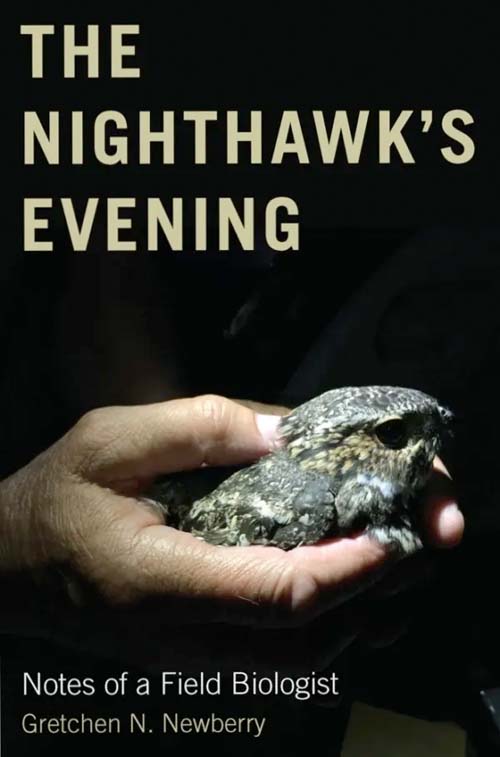 What hobbyist birder has not imagined leaving a current job or career to pursue their passion for birds? Gretchen N. Newberry’s book The Nighthawk’s Evening: Notes of a Field Biologist provides an in-depth look at the experience that can await someone who does just that. An employee for the city of Portland, Oregon, Newberry quit her job and headed off to Oregon State University at age 38 to study biology. Inspired also by the work and writings of Bernd Heinrich and Jane Goodall, she paints a vivid portrait of both her research and the object of her studies, the Common Nighthawk—North America’s most widespread and common nightjar. What hobbyist birder has not imagined leaving a current job or career to pursue their passion for birds? Gretchen N. Newberry’s book The Nighthawk’s Evening: Notes of a Field Biologist provides an in-depth look at the experience that can await someone who does just that. An employee for the city of Portland, Oregon, Newberry quit her job and headed off to Oregon State University at age 38 to study biology. Inspired also by the work and writings of Bernd Heinrich and Jane Goodall, she paints a vivid portrait of both her research and the object of her studies, the Common Nighthawk—North America’s most widespread and common nightjar.
In The Nighthawk’s Evening, Newberry traces her interest in nighthawks pretty much chronologically from her beginnings as an undergraduate at OSU studying the behavioral ecology of aerial insectivores (mainly swallows) through her doctoral work and beyond. The swallows piqued her curiosity about how nighthawks adapt to changing environments. This, along with concern about rapidly dwindling populations of grassland species generally, propelled her to graduate school at the University of South Dakota to learn how nighthawks are surviving in areas of rapid habitat loss.
Early on, Newberry realized how little is actually known about this familiar yet elusive bird, encountered in eastern North America as a crepuscular rooftop nester and seen most frequently in numbers during migration. In the West, where it is doing better than in the East, it occupies large territories in open grasslands (often burned or heavily grazed), forests with little understory, and even beaches. Its sharp white wing chevrons and piercing “peent” announce its unmistakable presence in the air, but its cryptic camouflage makes it very difficult to find when it is incubating eggs on a gravelly patch of bare ground or roosting lengthwise along a tree limb. Depending on insect availability, the bird can actively forage any time of day or night. | | | | | | A Philosophical Exploration of How Birds Live A review by Caitlin Kight Living As A Bird 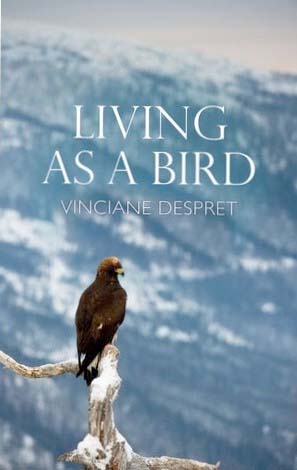 What is it like to be a bird? This is a question inevitably asked by those who watch, study, and/or love birds for long enough. It is a query that Tim Birkhead explicitly explored in his book Bird Sense: What It’s Like to Be a Bird, and which many other researchers have pondered more subtly in species monographs and other scientific writings. It is a query that has also been addressed more indirectly in creative pieces such as Maya Angelou’s poem “Caged Bird.” In her recent book Living as a Bird, philosopher Vinciane Despret finds another way of contemplating this question, and, notably, another way of answering it. What is it like to be a bird? This is a question inevitably asked by those who watch, study, and/or love birds for long enough. It is a query that Tim Birkhead explicitly explored in his book Bird Sense: What It’s Like to Be a Bird, and which many other researchers have pondered more subtly in species monographs and other scientific writings. It is a query that has also been addressed more indirectly in creative pieces such as Maya Angelou’s poem “Caged Bird.” In her recent book Living as a Bird, philosopher Vinciane Despret finds another way of contemplating this question, and, notably, another way of answering it.
Despret is a philosopher by trade, not an ornithologist, and the anecdotes shared throughout the book suggest that she is a relative newcomer to the world of birding. This is not to say that she is not knowledgeable; indeed, her book is filled with relevant natural history citations (fittingly, Birkhead gets a mention) and with personal observations and novel synthesis that would be right at home in the world’s top ornithological journals. Rather, these personal qualities are helpful to point out because they may help prepare the reader for how very philosophical this book is—not just in the colloquial sense of being “thoughtful,” but in the more literal sense of providing a “study of the basic ideas about knowledge, right and wrong, reasoning, and the value of things,” as Merriam-Webster defines it. If you’ve read the (brief) author bio on the back cover, you may think you’re prepared for this, but chances are you will still find it difficult to get your intellectual footing while making your way through this book. This is not a criticism. | | | | | | | | Rachel Carson, David George Haskell, and the Sounds of Silence 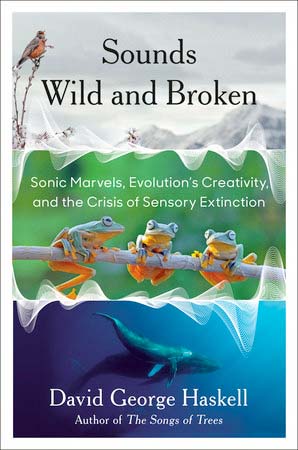 The similarities between Rachel Carson and David George Haskell seem simple, obvious. The opening fable of Silent Spring limns a once idyllic American town now deserted and silent. In this once pastoral scene, echoing Keats’ line, “no birds sing.” In Sounds Wild and Broken, Haskell, too, warns of a world without bird song. The similarities between Rachel Carson and David George Haskell seem simple, obvious. The opening fable of Silent Spring limns a once idyllic American town now deserted and silent. In this once pastoral scene, echoing Keats’ line, “no birds sing.” In Sounds Wild and Broken, Haskell, too, warns of a world without bird song.
But David George Haskell’s place in the lineage left by Carson, his connection to her, is far richer, more resonant than mere appreciation for bird song, what it might mean, for example, to still the voice of the White-crowned sparrow — brilliantly described by Haskell from Arctic tundra to Tennessee — that has developed regional dialects, even unique individual songs, by listening and learning from other sparrows.
Carson’s gift to us is found in her keen scientific research and real-life observations, her attentiveness, her wonder, awe and imagination, her empathy for other beings, however small or strange. Such empathy grows from Carson’s sensual awareness, the very awareness that resonates throughout Sounds Wild and Broken.
Both Haskell and Carson help us transcend the sensory boundaries of our lives and the strictures of society. We have painted too flat an icon of Carson. We picture her boldly testifying to Congress and bravely responding to the corporate critics and scientific hacks who try to smear her character and her science. The word sensual does not spring to mind. Read more | | | | | |  Isabel Wood: RCC Presidential Fellow Isabel Wood: RCC Presidential Fellow
Isabel Wood is the co-lead with Ross Feldner and Bob Musil of the RCC Bird Watch and Wonder Program and works with Mackay Pierce on communications and social media.
She is a senior at Duke University majoring in Environmental Science and Policy with a certificate in Documentary Studies. isabel.wood@duke.edu | | | | | |  The Rachel Carson Council Depends on Tax-deductible Gifts From Concerned Individuals Like You. Please Help If You can. The Rachel Carson Council Depends on Tax-deductible Gifts From Concerned Individuals Like You. Please Help If You can. | | | |  Sign Up Here to Receive the RCC E-News and Other RCC Newsletters, Information and Alerts. Sign Up Here to Receive the RCC E-News and Other RCC Newsletters, Information and Alerts. | | | | | | | | | | | |